Wikipedia:Modelling Wikipedia's growth
| This Wikipedia page needs to be updated. Please help update this Wikipedia page to reflect recent events or newly available information. Relevant discussion may be found on the talk page. |


| WikiStats |
|---|
| Main |
| General statistics |
| Breakdowns |
| Notes |
|
This page analyzes the article count data in Wikipedia:Size of Wikipedia and attempts to fit a simple numerical model of past and future growth to the observed article count size and growth data.
The rate of new articles initiated within the English Wikipedia grew exponentially until around 2007, though this is no longer the case. The rate of article creation is declining very slowly from its then-peak of around 50,000 new articles created per month. The two most credible growth models for the whole life of Wikipedia are a Gompertz function model which predicts that article creation will eventually asymptotically approach zero, and a modified Gompertz model (see below) which predicts that growth will continue indefinitely, but at a significantly lower rate than in the early days of Wikipedia. As of November 27, 2024, there are 6,916,836 articles. In recent years the increase in the number of pages has fallen from 372,000 in 2010 down to 164,000 in 2022 and 169,000 in 2023.
On the other hand, the total amount of text in Wikipedia articles has been increasing essentially linearly, and the growth rate is essentially unchanged since 2006. However, there is an increase in the growth rate in 2020. This implies not that contribution to Wikipedia is fading over time, but that relatively more of the work done is on expanding existing articles or even merging articles that are similar in scope rather than creating new ones.
Growth of the article count
[edit]The following graph shows the number of articles on the English Wikipedia from its creation in 2001 up to 2015.
Here, several models are presented to attempt to explain the observed general trends in article growth.
Old exponential model for article count of Wikipedia
[edit]Graphs of the article count for the English Wikipedia, from January 10, 2001, to September 9, 2007, based on statistics from this page and Wikipedia:Announcements. The two graphs show both logarithmic and linear y-axes. The graphs also show the approximate rate of article increase per day, along with the projected number of articles based on annual doubling referenced to January 1, 2003.
The growth in articles had been approximately 100% per year from 2003 through most of 2006, but has tailed off since roughly September 2006. The trend is no longer one of exponential growth, but has been closer to linear since that time.
Notes
A few notes on features of the graph:
- The start of the project showed a slow rise, which slowly increased in speed with time.
- The big slowdown in the rate of article creation in June–July 2002 was caused by major server performance problems, remedied by extensive work on the software.
- The sudden jump in article count in October 2002 is due to roughly 30,000 stub articles on U.S. towns and cities generated from a database being added by an auto-posting robot, Rambot, during an eight-day period. Although initially controversial as to whether these were "real" encyclopedia articles or merely "stubs", most of the Rambot articles have since been substantially expanded.
- Not counting the Rambot operation, the true maximum rate of article creation was in August 2006, when about 2400 net new articles were being added each day. From September 2006 through May 2007, the article count has increased by an average of about 1670 articles per day.
- During the first half of May 2007, the article growth rate dropped below 1500 articles per day, the lowest rate since October 2005. The growth rate has since rebounded to about 2000 articles per day from late July through early September 2007.
Critique of the exponential model
[edit]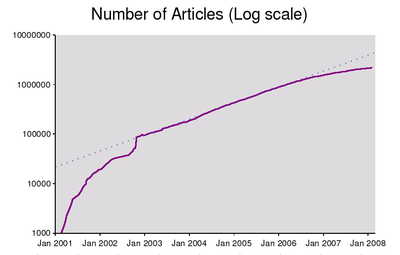
The exponential model of Wikipedia growth is based on the following:
- more content leads to more traffic
- which leads to more edits
- which generate more content
Moreover, the average rate of growth is assumed to be proportional to the size of the Wikipedia, as a consequence of which, the growth would be exponential.
The graph of article count on the right is plotted on a logarithmic scale, so exponential growth should manifest itself as linear behavior of the data. Between October 2002 and July 2006, the data do fit very well along the dotted line shown, while from July 2006 onwards there is a noticeable fall off from linear behaviour. Before October 2002, the behaviour is more complex.

The graph on the right below is a close-up of the data points that follow a linear trend: the best-fit line in red was computed using linear regression. From the slope of this best-fit line, the proper time of the exponential growth can be found, giving:
The previous expression means that the number of articles doubled once every 346 days from October 2002 to October 2006, to a very good approximation. If Wikipedia had kept up with this trend, as shown on the graph, the number of articles by December 2006 would have been 1,900,000, by June 2007 2,800,000 and by December 2007 4,000,000, although there has been a slowdown of the growth and Wikipedia has apparently ceased growing exponentially.

The graph on the right is an exponential growth projection made in July 2006. The number of articles on the English Wikipedia up to July 2006 is shown in red, and this is extrapolated in blue using an exponential function (approximately 38000*exp(0.0017t) articles, where t is the number of days since January 1, 2001).
By the end of 2006, when there were 1.5 million articles, the projection was already overestimating the growth by 10-15%, and the prediction of over 3 million articles by the end of 2007 is significantly more than the actual figure of about 2.1 million articles.
It has been hypothesized that the growth rate of Wikipedia consists of a constant number of articles per day, submitted by "hard-core" Wikipedians, with additional articles submitted by less enthusiastic Wikipedians proportional to the current article count of Wikipedia. In this model the growth rate should be a linear function of the size of Wikipedia.
Questions:
- Is this model even remotely valid?
- How long can exponential growth go on, or is this just really the early part of a logistic curve?
- What does this imply for server and traffic scaling?
Eventually there will probably be a point where the number of articles created each day will begin to slow down, due to a lack of things to write about. But it is probable that the amount of information in each article will begin to increase in lieu of an increase in the number of articles. Limitations on the (current) Wikipedia interface will cause a bottleneck of sorts, limiting the type (and by default, the amount) of growth to vertical monolingual growth patterns, as opposed to lateral cross-lingual ones.
Note that from the beginning of December 2005, only registered users can create new pages.
Quadratic model for article count of Wikipedia
[edit]- Note: At the end of 2008, WP:Size of Wikipedia#Annual growth rate used a simple model with a reducing rate of new articles to predict when growth would come to an end.
| Date | Article Count | Increase during Preceding Year |
% Increase during Preceding Year |
Average Increase per Day during Preceding Year |
|---|---|---|---|---|
| 2009-01-01 | 2,679,000 | 526,000 | 24% | 1437 |
| 2018-01-01 | ~4,759,000 | 12,775 | 0.26% | 35 |
| NOTE: January 2018 is projected from 2009/2008/2007 (adding 60,000 fewer articles each year). Final article count plateau is: 2,679k + 470 + 410 + 350 + 290 + 230 + 170 + 110 + 50k = ~4,759,000 articles (deleted/merged articles will balance the number of added articles). Assumes same attitudes about notability, merging & lists. | ||||
Extended-growth model
[edit]
In 2009, the continued strong growth indicated there was no obvious nearby midpoint in the growth for new articles. Although growth was slowing, it was slowing more gradually, and could be expected to continue beyond another 15 years, creating up to 10 million articles. The predicted date for the 3-million-article mark was believed to be in mid-August 2009 by then, though it only ended up happening between December 2009 and January 2010. [2]. The growth was supported by the need for various spin-off articles, such as unseen-hand and lost-world articles, millions of missing red-link articles, plus many thousands of new disambiguation pages needed to connect the other millions of pages. The new projected midpoint might occur in year 2011[needs update], although any massive auto-upload of numerous articles could change the schedule, such as a mass, automated effort to auto-generate red-link stubs with sources suggested from search-engine results. The continued strong growth fits the model reaching about 10 million articles, before deletions and merges would offset the increase of new articles being added.
Two-phase exponential model
[edit]The growth rate N'(t) of Wikipedia (number of new articles per unit of time) can be accurately modeled by two exponentials, one increasing ("phase 1") and one decreasing ("phase 2"), with a fairly sharp crossover around January 2006. In the following plots, the dots are the observed counts N(t) (cleaned and resampled at equal 28-day "months") and the respective increments N'(t) (new articles per 28-day month). The solid lines are the values of N'(t) and N(t) computed by the model.
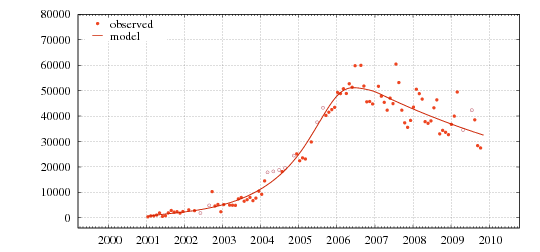 Growth rate N'(t) - linear scale |
 Growth rate N'(t) - log scale |
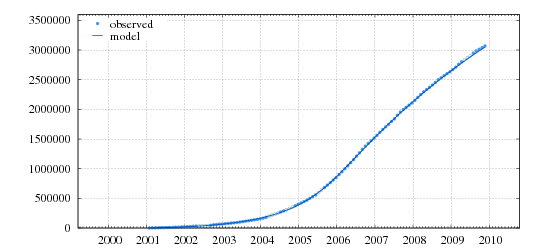 Article count N(t) - linear scale |
 Article count N(t) - log scale |
Seasonal modulation since 2006
[edit]Since 2006, there is also a strong semestral variation in the new article rate, with peaks in February and August. The following plots include this modulating factor:
 Growth rate N'(t) - linear scale |
 Growth rate N'(t) - log scale |
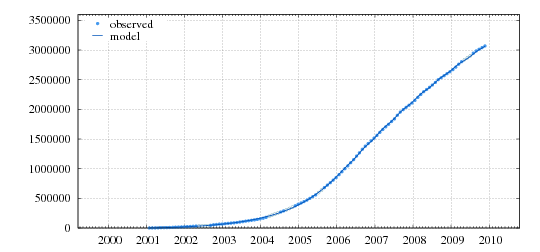 Article count N(t) - linear scale |
 Article count N(t) - log scale |
Implications
[edit]Some implications of this model:
- The slowdown is not a "natural" phenomenon but rather the consequence of some change in Wikipedia policy and/or tools.
- The "fertility" of Wikipedia's corps of editors (their output of new articles) is shrinking.
- Wikipedia will nearly stop growing before reaching 6 million articles.
Further info
[edit]Here is the text file with the data used to generate these plots. The first column is the time t, specifically elapsed days since January 1, 2001. Columns 2,3,4 are year,month,day. Column 5 is the observed article count N(t) on that date (cleaned and resampled). Column 7 is the value of N(t) predicted by the model. Columns 9 and 11 are the observed and predicted growth rates N'(t) in articles per "lunar" month (28 days). There is also a technical report describing the model and the data set.
Gompertz model (2010–)
[edit]This model is based on the Gompertz function. The Gompertz function is like a logistic function, but the future value asymptote of the function is approached much more gradually, in contrast to the logistic function in which both asymptotes are approached by the curve symmetrically.
The reasons for this new model are
- The growth rate function does not seem to be time-symmetrical, unlike the logistic function
- The percentage of article growth per month in the logarithmic graphs seem to be linear ( (1) and (2) ), as the Gompertz function
The formula for the Gompertz function for the en.wikipedia is , with
- a= 4378449 (the predicted maximum for about 4.4 million articles)
- b= -15.42677
- c= -0.384124
- t is the time in years since 2000-01-01 (so 2010-01-01 is t=10.00)
The expected maximum of the Gompertz model is between the logistic model and the Modelling Wikipedia extended growth.
See below 3 Gompertz model graphs, followed by 3 corresponding graphs of the Logistic model, a graph for a general comparison between the Logistic, Gompertz and the Extended Growth models, and a graph of the top 20 Wikipedia's which in general show the same behavior in Percentage of article growth.
Modified Gompertz model
[edit]A small but significant disparity has started to develop between the measured article count and the fitted Gompertz curve, with the article count rising faster than predicted since mid-2011.
One possible model, based on visual inspection of File:EnwikipediapercgrowthGom.PNG, might be a Gompertz curve with a small additional constant exponential growth term, , which would have the property that the small term would be "uncovered" only in the latter stages of the Gompertz growth curve, because it would be dominated by the term prior to that point.
Applying this to the data at Wikipedia:Size_of_Wikipedia#The_data_set, using a bit of numerical optimization to find the parameters, gives a much better fit to at least the most recent parts of the data, like this:
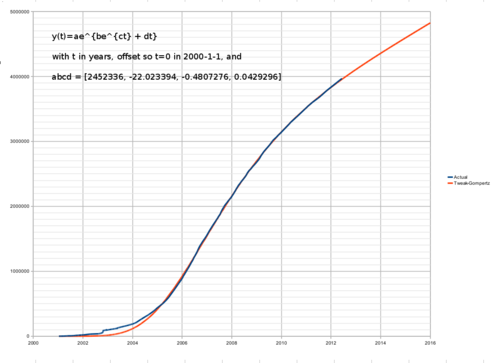
although with the extra parameter, it gets much easier to fit any curve, and there's a danger of overfitting. It also fits less well at the start, before the beginning of the fitting window in 2004.5 (done to remove the wild growth fluctuations of the Rambot-era data). But it adds some plausibility for the model, and at the very least provides a plausible-seeming new ad-hoc extrapolation that can be compared against the other candidates in the future.
Here are the corresponding percentage interval-to-interval changes, using the data series resampled into 0.05 year intervals, with a log scale on the y-axis, showing the closeness of fit from 2005 onwards:
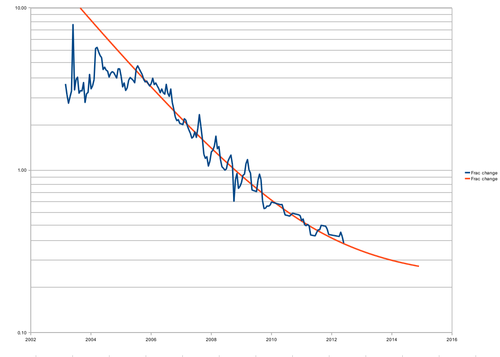
Here are the corresponding results for dewiki:, which didn't have the initial 2002-era server slowdown/Rambot perturbations found in the enwiki: data:
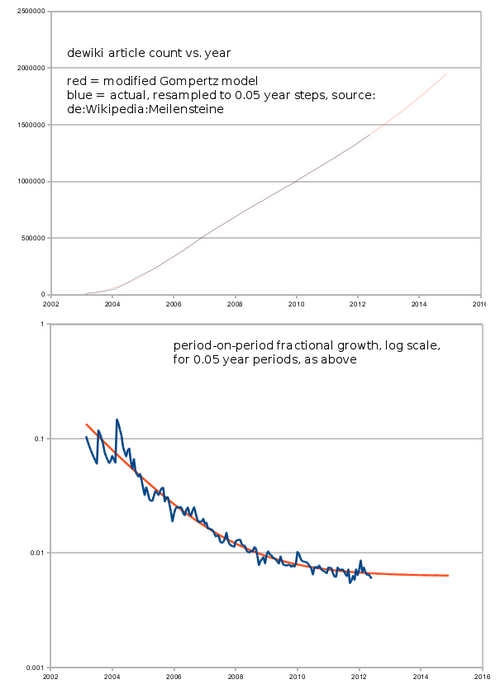
Data set for number of articles
[edit]As Erik Zachte's statistics for the English language wikipedia is not updated since October 2006, these are the figures I (HenkvD) use for generating the graphs. The data up to October 2006 was taken from one of Erik's Downloads. The data since I took manually each month at the date (or a day later) using the Special:Statistics page. See also Wikipedia:Size of Wikipedia#The data set for a list of values of the official count, recorded manually at irregular intervals.
Data set
|
|---|
|
Date, Number of articles 31/01/2001, 19 28/02/2001, 208 31/03/2001, 782 30/04/2001, 1121 31/05/2001, 1910 30/06/2001, 2390 31/07/2001, 3156 31/08/2001, 4605 30/09/2001, 7043 31/10/2001, 10814 30/11/2001, 13860 31/12/2001, 16442 31/01/2002, 18115 28/02/2002, 26764 31/03/2002, 29290 30/04/2002, 30969 31/05/2002, 32674 30/06/2002, 35576 31/07/2002, 38360 31/08/2002, 43121 30/09/2002, 52756 31/10/2002, 90524 30/11/2002, 95891 31/12/2002, 100526 31/01/2003, 106756 28/02/2003, 111859 31/03/2003, 117144 30/04/2003, 122656 31/05/2003, 129146 30/06/2003, 135647 31/07/2003, 144379 31/08/2003, 152627 30/09/2003, 161357 31/10/2003, 168662 30/11/2003, 178060 31/12/2003, 189674 31/01/2004, 200981 29/02/2004, 217064 31/03/2004, 239255 30/04/2004, 258781 31/05/2004, 277938 30/06/2004, 298265 31/07/2004, 320154 31/08/2004, 341883 30/09/2004, 364258 31/10/2004, 388155 30/11/2004, 415877 31/12/2004, 444892 31/01/2005, 469768 28/02/2005, 492743 31/03/2005, 521827 30/04/2005, 555758 31/05/2005, 591089 30/06/2005, 626000 31/07/2005, 674000 31/08/2005, 725000 30/09/2005, 768000 31/10/2005, 819000 30/11/2005, 866000 31/12/2005, 922000 31/01/2006, 961000 28/02/2006, 1000000 31/03/2006, 1054996 30/04/2006, 1110854 31/05/2006, 1166712 30/06/2006, 1224289 31/07/2006, 1289079 31/08/2006, 1359717 30/09/2006, 1412803 31/10/2006, 1462910 30/11/2006, 1510789 31/12/2006, 1559619 31/01/2007, 1611122 28/02/2007, 1663419 31/03/2007, 1715552 30/04/2007, 1763740 31/05/2007, 1811430 30/06/2007, 1857844 31/07/2007, 1926373 31/08/2007, 1985128 30/09/2007, 2030045 31/10/2007, 2070696 30/11/2007, 2109383 31/12/2007, 2153891 31/01/2008, 2203380 29/02/2008, 2259431 31/03/2008, 2312963 30/04/2008, 2354835 31/05/2008, 2395687 30/06/2008, 2436382 31/07/2008, 2485599 31/08/2008, 2539665 30/09/2008, 2568272 31/10/2008, 2607839 30/11/2008, 2642438 31/12/2008, 2678813 31/01/2009, 2721548 28/02/2009, 2769317 31/03/2009, 2821544 30/04/2009, 2863293 31/05/2009, 2898906 30/06/2009, 2930449 01/01/2010, 3145797 01/01/2011, 3517729 01/01/2012, 3835396 01/01/2013, 4133036 01/01/2014, 4412833 01/01/2015, 4681777 01/01/2016, 5044635 01/01/2017, 5321227 01/01/2018, 5541959 01/01/2019, 5773610 01/01/2020, 5989416 01/01/2021, 6219733 01/01/2022, 6431455 01/01/2023, 6595453 01/10/2023, 6722036 01/11/2023, 6737261 01/12/2023, 6752839 01/01/2024, 6764487 28/01/2024, 6775571 |
Other measurements of article growth
[edit]Edits per article
[edit]The following graph shows the mean number of edits per article, and is intended as a measure of the quality of the articles, assuming that editing improves the content.
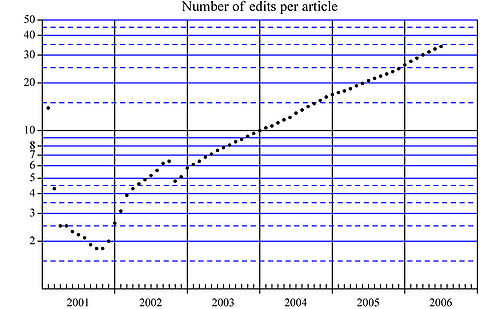
The graph is plotted in logarithmic scale, and this data also fits well with exponential growth starting from October 2002. The number of edits per article has since doubled once every 505 days, a rate consistent with Moore's law.
Modelling growth of Wikipedia page views per million
[edit]Using the Alexa page views per million data from Wikipedia:Awareness statistics (see [1] for a graph) in the period 1 January 2003 to 5 September 2005, filtering out all points less than 28 days away from the previous point (to avoid excessive weighting during time periods where points are densely sampled), and performing a linear least-squares fit of the logarithm of the data, gives the following approximate formula:
- log_e(page_views_per_million) = -50 + 5e-08 * unix_epoch_of_date
for n = 21 points fitted
This implies a doubling period of (log_e(2) / 5e-08) / 86400 days, which is approximately 160 days, and an annual growth factor in page views per million of approximately exp(5e-08*365*86400), which is approximately 5.
Playing around with different time periods and filter times, we get a range of results from which can reasonably say that Wikipedia's estimated page views per million doubling time is somewhere in the range 130 - 160 days, with the recent (2005) doubling time of 156 days or so being within the range of the longest-term doubling time of about 155 - 159 days, with the 2004 period being the exception to the long-term and short-term trends.
Modelling improvement in Wikipedia's Alexa traffic rank
[edit]
Applying a similar linear regression fit to the log of Wikipedia's Alexa traffic rank from October 2002 to September 2005 gives a similar result, with a halving period (lower is better for rank) of roughly 134 - 138 days over the long term, with a 2005-data-only halving time of 114 days! Since the page rank as of September 2005[update], was roughly 40, this suggested, if taken to logical extremes, and using the most cautious of the three figures, and rounding it to 4.5 months, that Wikipedia would reach:
- page rank 20 in 4.5 months
- page rank 10 in 9 months
- page rank 5 in 13.5 months
- be fighting its way into the top 3 in 18 months, and
- be fighting its way to the #1 spot in 22.5 months...
So, clearly this exponential growth had to stop or slow down, or it was going to be a wild ride...
November 2005 — the daily page rank averaging 34 and reached 31 in October.
January 2006 — the daily page rank averaging 20 for about a week; in line with the original predictions above.
April 2006 — averaging 16/17 this month, although in March it reached as high as rank 12, the then record.
July 2006 — deviating from predictions; Wikipedia was supposed to have reached rank 10 by now, yet for the whole of June we hovered between 16/18.
September 2006 — Heavily deviating from predictions; by the end of October, Wikipedia was supposed to reach rank 5, yet still only making small gains, hovering between 14/16 now. The climb up the rankings has slowed down - but for now we are still climbing! Wikipedia has broken the "50,000 reach" barrier, meaning we reach as many people as youtube.com and even more than myspace.com!
November 2006 — Alexa weekly rank now 12, and is still climbing, with occasional daily blips up to 11. Wikipedia once made the daily rank in the top 10 on 12th!
February 2007 — 18 months after the predictions, I think it's safe to say the model is flawed. We should be ranked as 3rd, but the high is 8, with the average being 10/11. We're still getting gaining popularity, just not as fast as expected.
May 2008 — Swaying between 7 and 8 for the past few months with 8 being slightly more common. The rise, though slow, continues.
December 2008 — The traffic rank continues to be around 8. No clear trend is evident in the rank, but the number of daily pageviews displays a steady decline since June 2008.
March 2009 — The traffic rank is consistently 7 for more than 6 weeks now, and has not been below 8 for three months. The half-year graph suggests a transition period from October to February for the move from rank 8 to 7. Pageviews have slightly recovered, again reaching July 2008 levels, though still far from those of June 2008.
June 2009 — Fairly consistently 7, with only intermittent falls to 8. Pageviews are fairly steady at around 0.5% of global, with a very slight upward trend evident.
September 2009 — Spending more time at 6, with intermittent returns to 7. Pageviews are about 0.55-0.6% of global with an upward trend still evident.
November 2009 - Mostly at 6, with occasional returns to 7. Pageviews are level at about 0.53-0.6% of global.
April 2011 — at 8. However, ComScore results as of January 2010 put all Wikimedia properties collectively at 5: see http://meta.wikimedia.org/wiki/User:Stu/comScore_data_on_Wikimedia
November 2012 — Back to 6, with 13% reach. For comparison, Google at position 2 worldwide has about four times the reach at 46%
December 2013 — Global rank 6, U.S.-only rank 7.
December 2014 — Global rank 7, U.S.-only rank 6.
June 2015 — Global rank 6, U.S.-only rank 6.
February 2019 — Global rank 5, U.S.-only rank 5.
January 2020 — Global rank falls into 10, U.S.-only rank also falls into rank 7.
August 2020 — Global rank falls again into 14, along with the U.S.-only rank, albeit more moderately, now at 8.
April 2021 — Global rank climbed into 13, U.S.-only rank steady, at 8.[3]
Growth of Wikipedia network
[edit]In the context of complex network theory there are a number of efforts to model the growth of Wikipedia network in which the nodes represent the articles and links are the hyper links between articles.[4][5] This type of models are based on simple local probabilistic rules which should reproduce different distributions of Wikipedias statistical variables. Analysis show that the distribution of the number of hyper links pointing to a given article have a very stable power law exponent for a number of Wikipedias in different languages. It was also confirmed that the reciprocity - ratio between the number of hyper links connecting two articles in both directions to the total number of hyper links is a very stable across the number of different Wikipedias.
See also
[edit]- Law of accelerating returns
- User:Dragons flight/Log analysis
- Wikipedia:List of academic studies about Wikipedia
- Wikipedia:Inflationary hypothesis of Wikipedia growth
- Wikipedia:Modelling Wikipedia's growth/Previous traffic predictions
References
[edit]- ^ Data from en:Wikipedia:Database download
- ^ "Wikistats - Statistics for Wikimedia Projects".
- ^ "wikipedia.org Competitive Analysis, Marketing Mix and Traffic - Alexa". www.alexa.com. Retrieved 2021-04-20.
- ^ Zlatić, Vinko; Štefančić, Hrvoje (2011), "Model of Wikipedia growth based on information exchange via reciprocal arcs", EPL, 93 (5): 58005, arXiv:0902.3548, Bibcode:2011EL.....9358005Z, doi:10.1209/0295-5075/93/58005, S2CID 17519212
- ^ Capocci, A.; Servedio, V. D.; Colaiori, F.; Buriol, L. S.; Donato, D.; Leonardi, S.; Caldarelli, G. (2006), "Preferential attachment in the growth of social networks: the internet encyclopedia Wikipedia" (PDF), Physical Review E, 74 (3): 036116, arXiv:physics/0602026, Bibcode:2006PhRvE..74c6116C, doi:10.1103/PhysRevE.74.036116, PMID 17025717, S2CID 8853906
External links
[edit]- Aniket Kittur, Ed H. Chi, Bryan A. Pendleton, Bongwon Suh, Todd Mytkowicz. Power of the Few vs. Wisdom of the Crowd: Wikipedia and the Rise of the Bourgeoisie. Presented at alt.CHI at ACM SIGCHI Conference 2007. April, 2007. San Jose, CA., a paper examining what user groups are behind most of the edits in Wikipedia.















